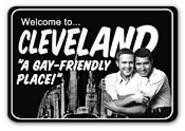The heart of Florida's thesis is even mushier: He argues that the size of a city's gay population directly relates to its prosperity. The larger it is, the fatter the wallet.
Which, of course, doesn't sound like a theory befitting Cleveland. Here in the Land of Voluminous Chest Hairs, any idea that involves coddling homos is, by definition, not a very good idea at all. But since our traditional method of economic development -- give free land and money to rich guys -- hasn't exactly worked (see the thousands of jobs that never showed up at Gateway), it's worth hearing Florida out.
His theory goes like this: A large gay population speaks to the vibrancy and tolerance of a city. More than anything else, this is what attracts the "creative class" -- the young, talented, and educated, the people who will fuel the scientific, technical, and artistic industries of the future. It's not that gay people are innately more inventive than your garden-variety breeder, says Florida. It's just that their presence is akin to a large billboard that reads, "Send us your eccentrics, your pierced, your huddled masses with the bad dye jobs who keep odd hours and don't wear ties." It's about personal freedom. And freedom, to the creative class, is better than gold.
Florida has the ammo to back it up. It comes in the form of Atlanta, Austin, Boston, Denver, Minneapolis, San Francisco, Seattle, and D.C. Some of these cities are old and beaten. Others are colder than Martha Stewart's smile. One is even in Texas. They have but three things in common: large gay populations, a huge influx of skilled workers, and America's freshest economies.
All of which doesn't fare well for Cleveland. To say we've cultivated our gay community is like saying you really want George Bush to be your Scrabble partner. "I don't think Cleveland is viewed as a tolerant city yet," says John Farina, head of the Log Cabin Republicans.
This isn't to say things blow. There are blossoming gay neighborhoods in Detroit-Shoreway, Ohio City, Tremont, and even Old Brooklyn. It's no coincidence that the two suburbs most attractive to young people -- Lakewood and Cleveland Heights -- also have the region's largest gay populations.
There is also no major, organized opposition. At least not the way there is in Cincinnati, where city law bars the protection of gays and lesbians from discrimination, and a vociferous band of psychos, called Citizens for Community Values, will soon begin suing public schools for the damage done to kids exposed to "homosexuality education."
"I haven't had a negative time in Cleveland because of my sexuality," says Tim Marshall, who moved to town a year ago.
Yet a marketing campaign centered on the message "We Will Not Sue You or Kick Your Ass -- At Least Not That Often," does not a welcome mat make. Fact is, Cleveland -- particularly Official Cleveland -- has always treated the gay community like something that should be carried in a brown paper bag.
Take former Mayor Mike White, who was "very involved" with gay issues, says Farina, "but it was always behind the scenes. He would never take credit for it." He feared a backlash.
The same goes for corporate Cleveland. Martha Pontoni, publisher of Gay People's Chronicle, says she still encounters businesses that will throw her paper out or refuse to advertise because they "don't want people to think [they're] gay."
No one can remember a business group actually reaching out to gay folk. "Not that I know of," says Laura Boustani of the Greater Cleveland Growth Association. "But we have a new effort for the attraction of talent and business: the Northeast Ohio Regional Marketing Initiative." Expect a very nice slogan.
Such are the ways of the Old World city, says Michael Orange, principal planner for Minneapolis. Places like Cleveland, Pittsburgh, and Detroit were built around Fortune 500 companies -- or more accurately, the tastes of their CEOs. They commuted to the city for work, maybe a night in the luxury box, an evening with the orchestra. The idea was to build stuff "they could show off to their other CEO friends," says Florida.
It mattered not if there were bike trails or nightclubs or downtown sidewalks that rolled up at dusk. "They do what's best for the CEO first," says Orange.
Contrast this with Minneapolis, which learned to welcome everyone from the Hmong to lesbians years ago. It not only invested heavily in recreation, small arts groups, and nightlife, but it routinely elects gays to the city council and state legislature. The message: You can be free here. And that begot a 20-year influx of skilled labor.
Today, its Warehouse District has 120 restaurants, and the city can't build downtown housing fast enough to meet demand. "I'm amazed at Minneapolis," says Florida, who recently visited the city. "The downtown was just humming, just rocking at night."
Cleveland, with lower taxes, better weather, and wonderful old architecture, could do the same, asserts Orange, a Cleveland native. But instead of chasing convention centers, it must support recreation, music, and festivals, according to Florida. It must focus on Case Western and the Cleveland Clinic. It must encourage immigration. And, perhaps most important of all, it must pass a strong gay rights ordinance.
"Those things are very important," says Florida. "They hang a sign that says 'Creative people come here,' instead of 'Creative people leave.'"
He points to Austin, which has no downtown, a second-rate university, ranch-style housing, and few parks, yet it's managed to become the commercial and cultural power of the Southwest. "How could Austin beat the bejesus out of Cleveland and Pittsburgh?" asks Florida. "The only explanation can be the attitudes."


